Beef Cattle Parts and Breeds INTRODUCTION TO ANIMAL

Beef Cattle: Parts and Breeds INTRODUCTION TO ANIMAL SCIENCE AG. 140


1. poll

2. neck

3. loin

4. hooks

5. rump

6. tailhead

7. pins

8. hock

9. leg

10. stifle

11. flank

12. Fore flank

13. forearm

14. dewlap

15. shoulder

16. body/side

17. Heart girth

18. Hind quarter

19. Frame size

20. sheath/underline

21. twitch

22. brisket

23. shank

24. muzzle

Breeds and Classifications of Beef Cattle

There are two subspecies of cattle. Bos taurus cattle of Europe, north-eastern Asia, and parts of Africa

Bos indicus Cattle originally from South Asia/India Called Zebu

Definition of a breed. Animals that, through selection and breeding, have come to resemble one another and pass those traits uniformly to their offspring.

Categories of Beef Cattle Breeds British Exotics (European) from continental Europe Zebu Cross breeds or Composites

British Breeds were developed in the British Isles and were brought to the United States in the late 1700 s through the late 1800 s. Angus (Black and Red), Hereford (Horned and Polled), and Shorthorn are the primary British breeds.

Exotics include Charolais, Chianina, Gelbvieh, Limousin, Maine Anjou, Salers, and Simmental. majority of these breeds are relatively new to the U. S. , being imported in the late 1960's and early 1970's primarily to improve the growth rate and leanness of existing breeds

British vs. Exotics British 1)Smaller at maturity 2)Mature earlier 3)Higher fertility 4)Calving ease 5)Yield less 6)better quality Exotics 1)larger at maturity 2)mature later 3)leaner meat 4)more yield 5)less quality 6)calving difficulty when crossed with British breeds

English Breeds: Aberdeen Angus Originated in Aberdeen, Scotland Polled Black

First came to the U. S. when George Grant brought five bulls to the Kansas prairie in 1873 When crossed with Texas Longhorns, hornless black calves that wintered better were the result. “Old Jock” is #1 in the Angus Registry “Old Granny” was killed by lightning when just past 35 years of age; produced 29 calves.

Red Angus Same origins as black Angus Banned from registry in U. S. in 1917; Red Angus registry established in 1954 Original “red” gene dates back to a dun cow from Norse invaders

Hereford Originated in Herefordshire England in 1742 Were bred for economical feed utilization horned

Herefords were first brought to the U. S. in 1817, to Kentucky, by Henry Clay “The Great Improver” – when crossed with longhorns, it greatly improved the carcass.

Polled Hereford Same as a Hereford, but polled or naturally hornless. Developed in the U. S. in the late 1800’s.

Shorthorn Developed in England in the late 1800’s Used as a dual-purpose breed May be red, roan or white

Two different types were developed in the 1900’s ◦ Milking Shorthorns ◦ Beef Shorthorns

Texas Longhorn

Texas Longhorn First set foot on north American soil 500 years ago Descendents of Spanish-Andalusian cattle brought to Mexico by the Spaniards Hearty, lean cattle that dominated the Great Plains of the U. S. Great foraging ability; able to withstand poor climate

Crossbreeding with Angus and Hereford breeds nearly caused the extinction of true Texas Longhorns by the early 1900’s. Natural range was decimated by fencing and the ploughing of natural pasture land.

Quiz Identify the following breeds of cattle.

1.

2.

3.

4.

5.

6.

Review What breed is the predecessor to modern domestic cattle? What are three categories of cattle breeds? How do those three categories differ?

Exotics include Charolais, Chianina, Gelbvieh, Limousin, Maine Anjou, Salers, and Simmental. majority of these breeds are relatively new to the U. S. , being imported in the late 1960's and early 1970's primarily to improve the growth rate and leanness of existing breeds

Charolais First imported into the U. S. by the King Ranch in Texas, in 1936 (bought from Mexico) Originated in France Large framed breed of cattle with bulls reaching 2, 000 lb to 2500 lbs. Cows weigh from 1200 to 2000 lbs.


white or creamy white in color, but the skin carries appreciable pigmentation naturally horned beef animal Currently, polled Charolais have been developed


graze aggressively in warm weather, withstand reasonable cold, and raise heavy calves

Chianina Originated in Italy First importation was Chianina semen in 1971; producing an Angus/Chianina cross Import of animals was not allowed from countries where Hoof in Mouth disease had occurred


Fullblood Chianina have short hair that varies from white to steel gray in color. Bulls are often a darker gray around their front ends.

Both sexes have black pigmented skin, points and mucosa. The short horns curve forward and are usually black in the younger animals but become lighter, beginning at the base, as the animals mature.


The most noticeable characteristic of the breed is the extensive and welldefined muscling. The shoulders, back and rear quarters are especially well formed. The legs are longer than most breeds and the bodies are not proportionally as long as some breeds that have shorter legs. The faces are rather long and straight. The breed is often referred to as a "terminal" breed by cattlemen. This infers that the primary use of the breed is as the sire to animals which will all be marketed. The herds they are used in are frequently crossbred and the Chianina bulls provide an outstanding growth rate in the offspring of these crossbred females.


Limousin The first Limousin bulls imported permanently into the United States did not arrive until the fall of 1971 from Canada golden-red cattle with wheat colored undermarkings deep chest, a strong top-line, well-placed tailhead and strongly-muscled hindquarter


the Canadian government had not permitted any Limousin bulls to leave the country except for short periods for exhibition purposes, and then only if the owners posted a large bond that was refunded when the animal returned to Canada.


The first U. S. import, Kansas Colonel, was born and raised in Canada and was imported by Bob Haag of Topeka, Kansas, for a group of Kansas Limousin breeders.

Red Angus vs Limousin

Maine-Anjou Originated in Northwest France Semen first imported to the U. S. in 1969


mature bulls weigh from 2200 to 3100 pounds on the average. Mature cows will range from 1500 to 1900 pounds.


The coloring is a very dark red with white markings on the head, belly, rear legs and tail. White on other parts of the body is also common.

Simmental vs. Hereford

Salers Originated in France First imported in semen form from Canada First bull imported to the U. S. in 1975


Salers cattle are typically horned and dark mahogany red in color, however a growing number of polled and black Salers are available. The availability of polled genetics in addition to both red and blackgives Salers the advantage of breeding program flexibility.


Miscellaneous Cattle Breeds The following slides are breeds that need to be noted before looking at composites.

Double Muscled Cattle Belgian Blue Parthenais Piedmontese

Belgian Blue

Belgian Blue Have double muscling (double in size, not two sets) Originated in Belgium Double muscling is due to a gene that supresses the production of myostatin (hormone that inhibits muscle growth and differentiation)

Parthenais Originated in France

Piedmontese Believed to be descendents of crosses between Aurochs and Zebu cattle Originated in Italy Born fawn colored, mature to gray/white color


Brahman Originated in India Breed is adapted to inadequate food supplies, insect pests, parasites, diseases and the weather extremes of tropical India Large ears contribute to blood cooling All Brahmans are Bos indicus, but not all Bos indicus are Brahmans.


◦ Hair Coat. The short, thick, glossy hair coat reflects much of the sun's rays ◦ Skin Pigmentation - black pigmented skin keeps out the intense rays of the sun. ◦ Loose Skin - loose skin on the Brahman is contributes to its ability to withstand warm weather by increasing the body surface area exposed to cooling. ◦ Sweating Ability. Brahmans have sweat glands and the ability to sweat freely through the pores of the skin ◦ Internal Body Heat -they produce less internal body heat in warm weather than do cattle of European breeds.


Scottish Highland

long horns and long wavy coats that are coloured black, brindle, red, yellow, white, silver (looks white but with a black nose) or dun originated in the Highlands and Western Isles of Scotland were first mentioned in the 6 th century AD hardy breed milk generally has a very high butterfat content, and their meat, regarded as of the highest quality, is gaining mainstream acceptance as it is low in cholesterol.

Crossbreeds or Composites Crossbreeds are produced using characteristics of two to three different breeds Beefmaster, Santa Gertrudis, Braford, Brangus and Charbray are only a few. Black Baldies are composites that are not a breed

Beefmaster

Developed at the Lasater Ranch in Texas ¼ Hereford, ¼ Shorthorn, and ½ brahman Stress was put on beef production No specific horns, hide, or color

Santa Gertrudis Developed on the King Ranch in Texas 5/8 shorthorn, 3/8 Brahman Deep cherry red in color Heat and tick resistant


Good mothering and milking ability with ease of calving Steers have high weight gains on both pastures and in feedlots

Braford 3/8 Brahman, 5/8 Hereford Developed in Florida in 1947 Herefords were not adapted to the climate, so crosses were made with Brahmans Characteristics include early puberty, fertility, calving ease, optimum milking and maternal ability


Charbray 5/8 Charolais and 3/8 Brahman Well adapted to regions of high humidity, heat and insects Rapid growth and outstanding feed conversion Reach slaughter weight at 12 to 15 months
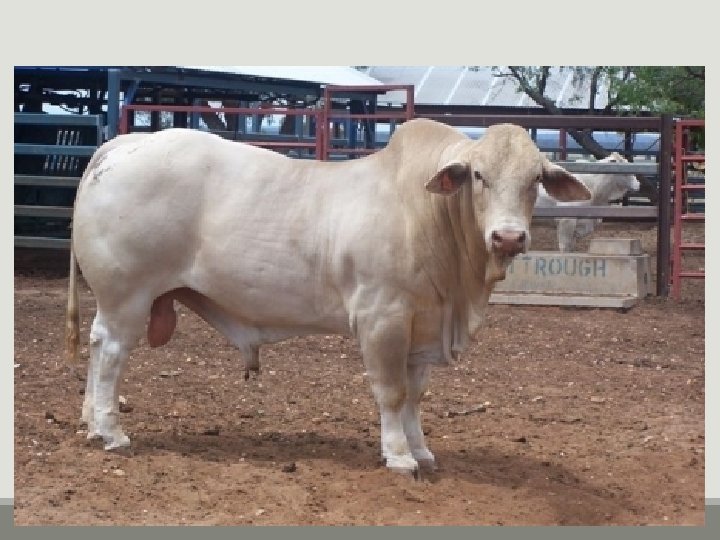
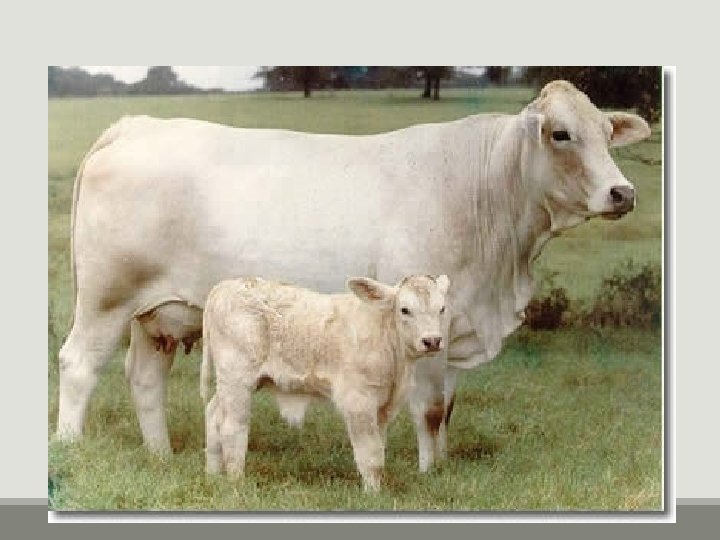

Brangus 3/8 Brahman, 5/8 Angus Desireable animal having the carcass quality of an angus with the heartiness of a Brahman
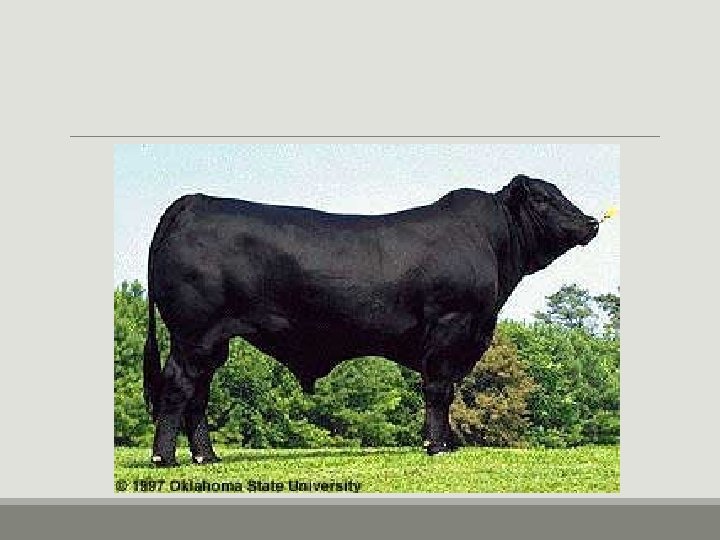
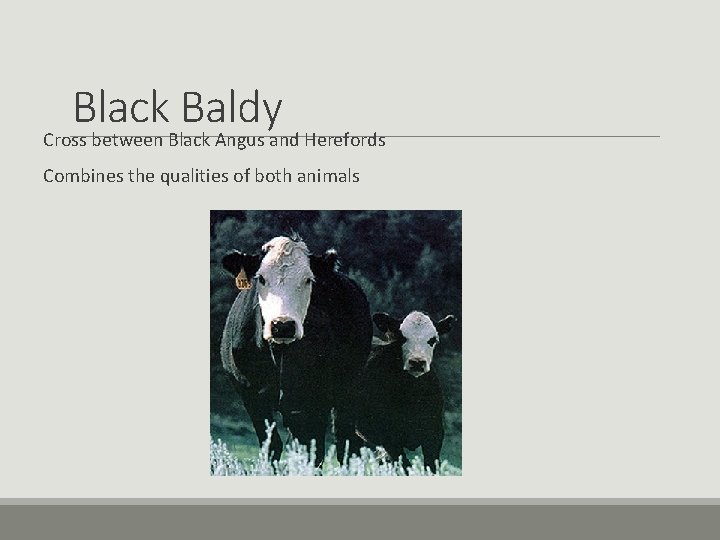
Black Baldy Cross between Black Angus and Herefords Combines the qualities of both animals
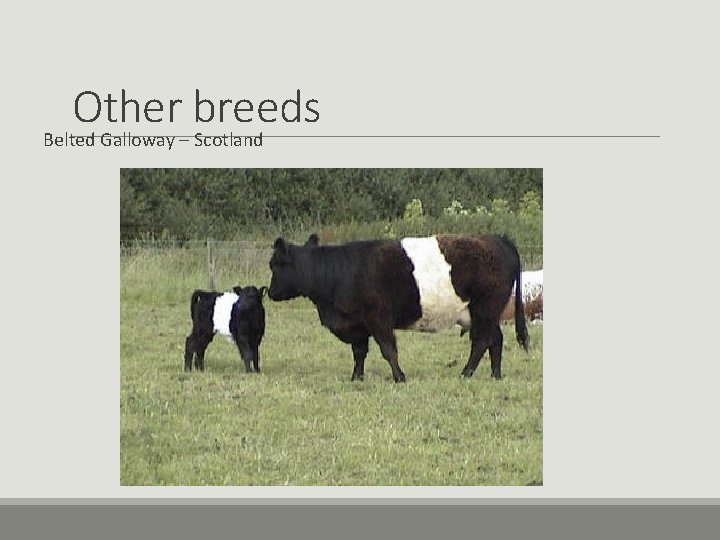
Other breeds Belted Galloway – Scotland
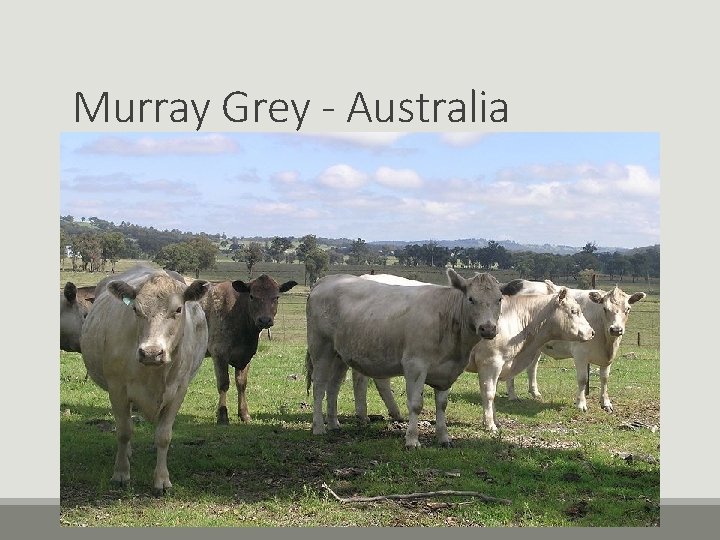
Murray Grey - Australia
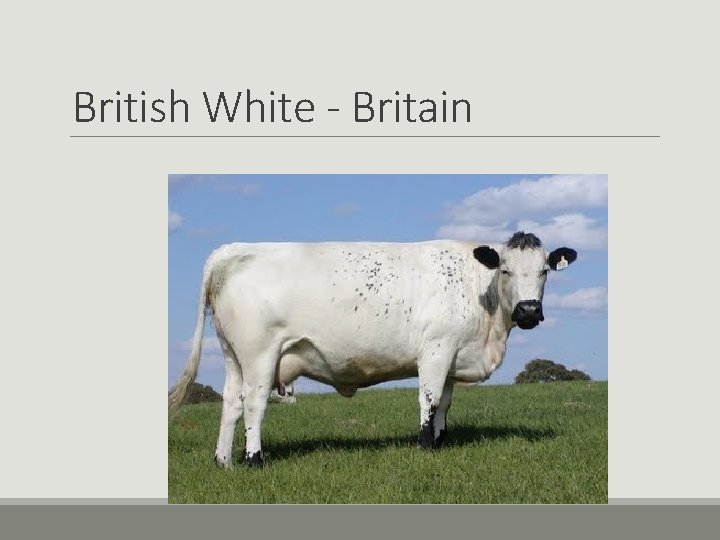
British White - Britain
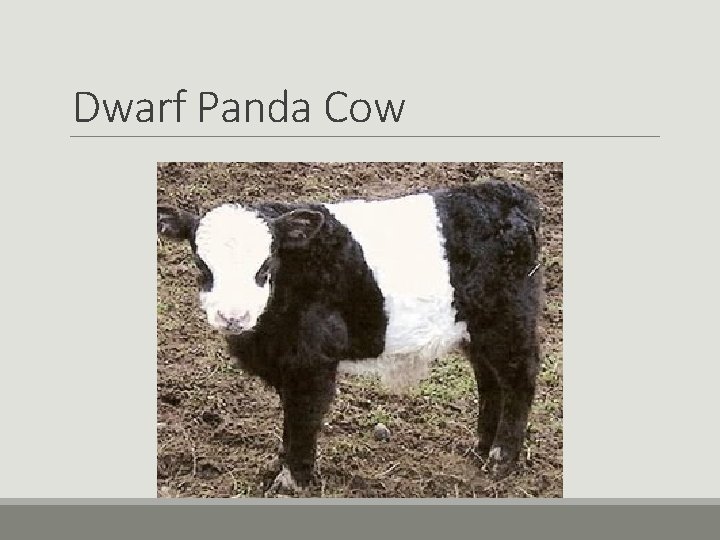
Dwarf Panda Cow
- Slides: 113